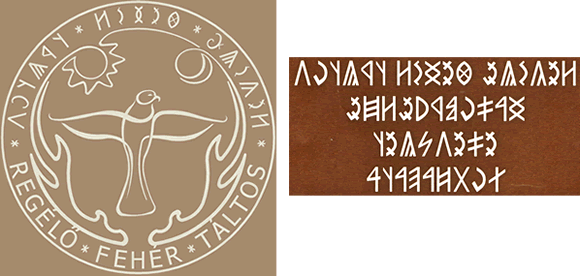Yesterday at the Llangollen International Musical Eisteddfod I was quite surprised to see Hungarian Runes / Rovás (Székely Rovásírás) being used. They appear on the logo and publicity material of a Hungarian drumming group who perform Hungarian folk dances and songs that date back to the 11th century, a time when the Székler Magyars were writing with the rovás.
The group, called Feher Taltos Traditional Hungarian Drummers (Regélő Fehér Táltos), is very good, and well worth going to see.
Here are some examples:

I think the bit of writing on the right, which comes from the group’s flyer, reads, “Regélő Fehér Táltos Hagyományőrző Egyesület Dobcsapata”, which I assume is the group’s name in Hungarian.
I’m happy to read about my mother tongue at omniglot.com :).
I can read rovásírás a little. (Maybe I should learn the whole rovás alphabet…)
They say Hungarian runes fit the Hungarian language better than latin alphabet.
Maybe a cursive form of the runes can be developed and be used. That will make more destinction for the Hungarian nation, I believe.
Who says these fit Hungarian (a fave language of mine) better than the current orthography (one of the most linguistically sound in Europe)?
In recent visits to Budapest I’ve seen a tiny bit of symbolic usage of these (as opposed to actual usage for the sake of writing) but it seems to be connected with some of the less savory strains of Hungarian nationalism.
Color me skeptical – they do look cool though.
I don’t know about the runes, but of course the Latin alphabet only fits Hungarian with the addition of digraphs and diacritics. Not that this point is unique to Hungarian, but a system which represented each sound with a single letter could be argued to “fit better”.
However, it would make Hungarian even more inaccessible to foreigners than it is already – which doesn’t strike me as being a victory.
But no argument from me on the final point – they do look cool!
A couple of practical problems (judging from a cursory glance at the omniglot page for these).
1. Not all the vowels are written all the time (probably not entirely necessary for native speakers but helpful for the rest of us).
2. There’s not symbol for ë, which is important in writing western dialects where it’s distinct from e.
TJ: Is there even such thing as a cursive form of a runed script that’s easy to write with a pen? The shape of letters in rovásírás allows for lots of contractions, because you can use just one vertical line instead of two where the sides of two letters are next to each other. Letters like “t”, “i”, and “r” can be tacked to the side of most letters, even curved ones. The only problem is with “k” which is a too frequent letter in Hungarian but has a hard to write symbols. This makes it much easier to write the letters with a chisel, but I don’t think it helps much with a pen.
mcihael farris: Sure, but if you want to, you could write rovásírás in such a way to write all vowels explicitly, possibly abbreviating most of the “e” as upper dots. As for a separate symbol for “ë”, it could be possible to invent one, but most of us probably just could not write it correctly now, as I for one do not know which word has it where.